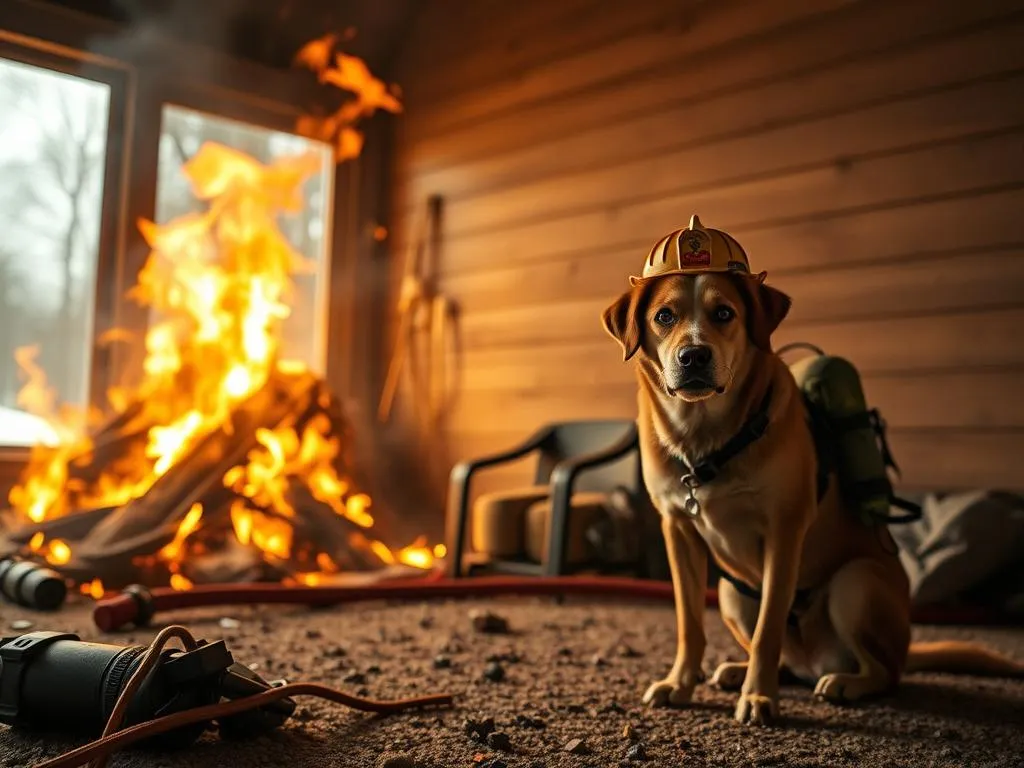
Introduction
Fire safety is a critical concern for every household, but it takes on an even greater significance for homes with pets. According to the National Fire Protection Association, approximately 1,000 house fires are reported each year due to pets, often resulting from common behaviors like knocking over candles or chewing on electrical cords. Moreover, an estimated 40,000 pets die in house fires annually, highlighting the urgent need for pet owners to understand how to prepare for a house fire with a dog.
This article aims to provide a comprehensive guide to ensure the safety of both you and your furry friend in the unfortunate event of a fire. By understanding risks, creating a fire safety plan, and preparing your dog for emergencies, you can significantly increase the chances of a safe evacuation.
Understanding the Risks of House Fires
Common Causes of House Fires
House fires can arise from a variety of sources, with cooking being the leading cause. Other common culprits include electrical issues, heating equipment, and careless smoking habits. However, pet ownership introduces unique risks. For instance, dogs and cats can inadvertently start fires by knocking over candles, tipping over space heaters, or playing with electrical cords.
The Impact of House Fires on Pets
The consequences of house fires extend beyond property damage. According to the American Humane Association, over 40% of pets do not survive house fires, primarily due to smoke inhalation and panic. The emotional and psychological effects on pets can be profound, leading to anxiety, fear, and behavioral changes long after the incident. Understanding these impacts emphasizes the necessity of preparing for a house fire with your dog in mind.
Creating a Fire Safety Plan
Assessing Your Home for Fire Hazards
The first step in creating an effective fire safety plan is to identify potential fire hazards in your home. Look for:
- Overloaded electrical outlets
- Clutter around heating sources
- Unattended cooking appliances
- Candles or open flames within reach of pets
Regularly checking and maintaining your home can significantly reduce the risk of fire.
Developing a Fire Escape Plan
Once you’ve assessed your home, it’s time to create a fire escape plan that includes your dog. Here are essential steps:
- Identify Escape Routes: Map out at least two escape routes from each room.
- Designate a Meeting Place: Choose a safe spot outside your home where everyone, including your dog, will gather.
- Practice Your Escape: Ensure all family members, including those with pets, are familiar with the escape routes.
Practicing the Plan
Drills are crucial for both humans and dogs. Regularly practicing your fire escape plan helps everyone know what to do in an emergency.
- Incorporate Your Dog: Use treats and praise to encourage your dog to follow you during drills.
- Desensitize to Loud Noises: Fire alarms can be startling. Gradually expose your dog to the sound to reduce anxiety during an actual emergency.
Preparing Your Dog for Emergencies
Training Your Dog for Emergency Situations
Training your dog to respond to basic commands can be invaluable during emergencies. Commands like “come,” “stay,” and “leave it” can help guide your dog to safety. Additionally, consider desensitizing your dog to loud noises and chaotic environments, which can help them remain calm during a fire.
Creating a Dog Emergency Kit
Preparation also involves having an emergency kit for your dog. Essential items to include are:
- ID: Ensure your dog has a collar with an ID tag.
- Food and Water: Pack enough food and water for at least three days.
- Leash and Muzzle: A leash will help control your dog during evacuation, while a muzzle may be necessary if they are frightened or stressed.
- Medications: Include any medications your dog may need.
Keep this kit in an easily accessible location so you can grab it quickly during an emergency.
Identifying Safe Spaces for Your Dog
Designate a safe area within your home where your dog can go during a fire. This area should be easily accessible and away from potential hazards. Train your dog to recognize this space and encourage them to go to this area during drills.
During a House Fire
Recognizing the Signs of a Fire
Being able to recognize the signs of a fire is crucial. Common indicators include:
- Smoke or unusual smells
- Flickering lights or buzzing sounds from electrical outlets
- An increase in your dog’s anxiety or unusual behavior
Teaching your dog to alert you to these signs can be beneficial. For example, if they start barking excessively or trying to get your attention, it might indicate something is wrong.
Evacuation Procedures with Your Dog
When a fire breaks out, quickly evacuating your dog is essential. Here’s how to do it safely:
- Stay Low: Smoke rises, so stay as close to the ground as possible.
- Use the Leash: Always use a leash to maintain control over your dog during evacuation.
- Calm Behavior: Keep your voice calm and reassuring to help your dog remain composed.
Communicating with Emergency Responders
If firefighters arrive, it’s crucial to inform them about your dog. Use ID tags and microchips to ensure your pet can be identified and returned to you after the incident.
After a House Fire
Assessing Your Dog’s Well-Being
After a fire, the first step is to assess your dog’s well-being. Look for signs of stress or trauma, which may include:
- Excessive barking or whining
- Hiding or seeking solitude
- Changes in appetite or energy levels
If you notice any concerning behaviors, consult with a veterinarian for advice and potential treatment options.
Recovery and Rebuilding
Helping your dog adjust after a traumatic experience is vital. Here are some strategies:
- Routine: Establish a consistent daily routine to provide structure.
- Reassurance: Spend quality time with your dog, offering comfort and reassurance.
- Professional Help: Consider working with a professional dog trainer or behaviorist if your pet continues to show signs of distress.
Revising Your Fire Safety Plan
After experiencing a house fire, it’s essential to update your fire safety plan. Reflect on what went well and what could be improved. Regularly revisit your plan to ensure it remains effective and relevant.
Conclusion
In conclusion, the importance of preparing for a house fire with your dog cannot be overstated. From understanding the risks to creating a fire safety plan and preparing your dog for emergencies, every step you take can make a significant difference in ensuring the safety of your beloved pet. By staying proactive and informed, you can protect your furry friend and create a safer environment for all.
Taking these preventive measures today can save lives tomorrow. Don’t wait for a fire to happen; start preparing now to ensure both you and your dog are ready for any emergency.









